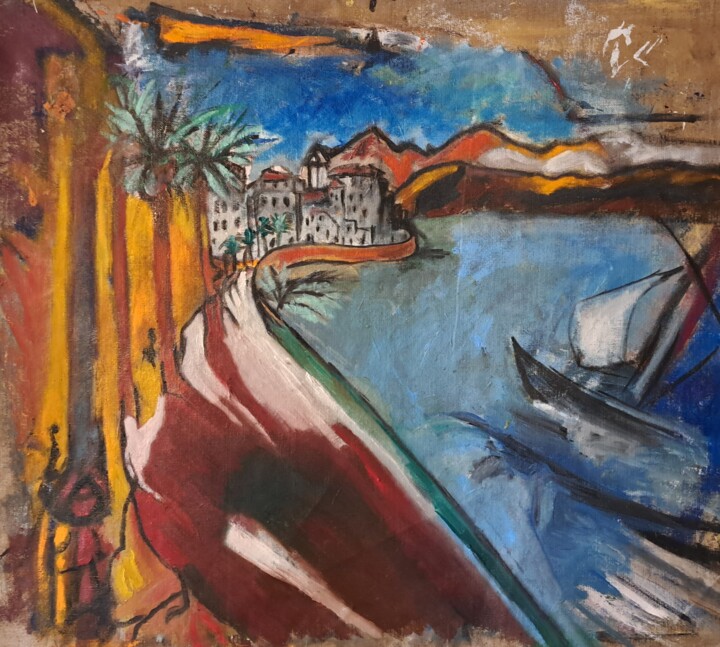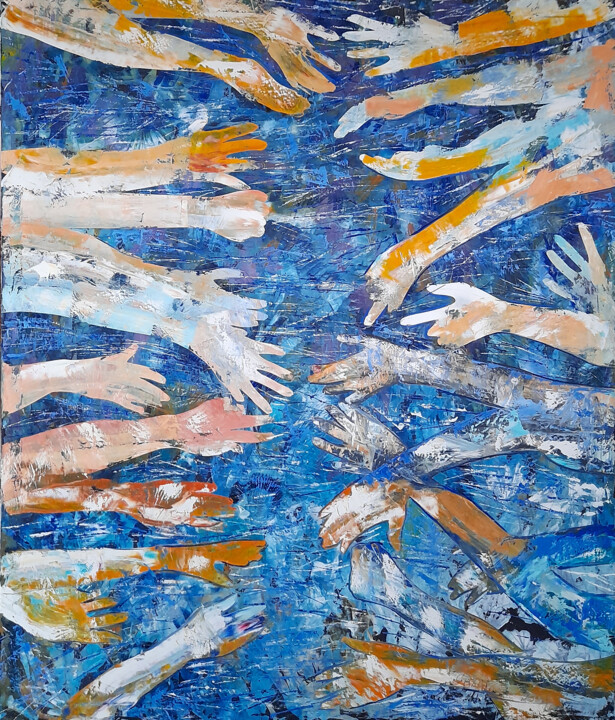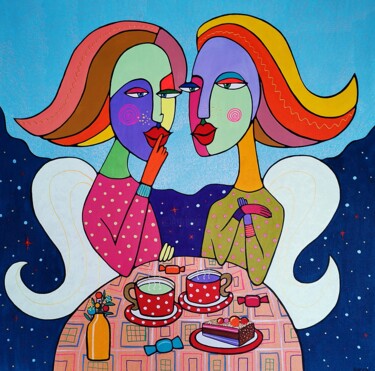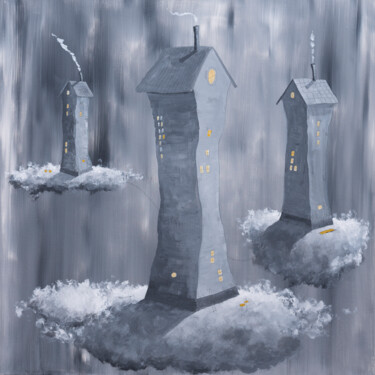18,620 원본 삽화, 한정판 및 판화:
순수 예술 스타일를 어떻게 정의하나요?
나이브 아트란?
순진한 예술이란 무엇이며 순진한 예술을 어떻게 정의합니까? 본당 회화는 예술에 대해 잘 몰랐던 앙리 루소(Henri Rousseau)와 같은 예술가들에 의해 시작된 예술 스타일입니다. 대부분의 경우 네이브 아트는 전문 예술가가 하는 훈련과 교육을 받지 않은 사람이 만든 시각 예술로 정의됩니다. 전문 예술가가 이 스타일을 모방하려고 할 때 종종 "원시주의"라고 합니다.
순진한 예술의 정의는 무엇입니까?
네이브 아트는 일반적으로 전문 아티스트가 수행하는 정식 교육 및 교육(해부학, 미술사, 기법, 관점, 보는 방법)을 받지 않은 사람이 만든 시각 예술로 정의됩니다. 숙련된 예술가가 이 스타일을 모방하려고 할 때 원시주의, 사이비 순도 예술 또는 가짜 순도 예술이라고도 합니다.
민속 예술과 달리 본당 예술은 특정 대중 문화 맥락이나 전통에서 나올 필요가 없습니다. 사실 적어도 선진국과 인쇄 혁명 이후 대중적인 인쇄물과 다른 매체를 통해 퍼진 지역 미술 전통에 대해 알지 못하는 것은 불가능합니다. 순진한 예술가는 그래픽 원근법 및 구성 규칙과 같은 "순수 예술" 규칙에 대해 알고 있지만 잠재력을 최대한 발휘할 수 없거나 사용하지 않습니다. 반면 아웃사이더 아트("art Brut"라고도 함)는 비슷한 배경에서 나왔지만 주류 예술계와 거의 관련이 없는 작품을 말합니다.
네이브 아트는 어린아이처럼 단순하고 정직하기로 유명하여 종종 모방되는 이유입니다. 이런 종류의 그림은 일반적으로 평면적인 그림 스타일과 단순한 깊이를 보여주는 방법을 가지고 있습니다. 1844년부터 1910년까지 살았던 프랑스 후기 인상파 화가인 앙리 루소는 파블로 피카소에 의해 발견되었으며 "소박한 예술"의 가장 중요한 화가 중 한 사람이었습니다.
이 용어의 의미와 민속 예술 및 외부인 예술과 같은 다른 용어로 "종료"되는 위치에 대해 약간의 의견 차이가 있습니다. 네이브 아트는 일반적으로 회화나 조각과 같은 독학 예술가가 만든 순수 예술 작품을 설명하는 데 사용됩니다. 반면 민예는 일상생활에서 사용할 수 있는 것을 말한다. 그러나 이러한 차이점에 대해 논쟁이 있었습니다. "Provincial"은 특히 그림과 건물에 사용할 수 있는 또 다른 단어입니다. 그것은 주로 전통적인 훈련을 받았지만 우연히 대도시 또는 법원 표준에 미치지 못하는 예술가의 작품을 설명하는 데 사용됩니다.
나이브 아트의 특징은 무엇인가요?
사람들은 종종 본당 예술을 교육이나 학위를 받지 않은(또는 많이 받지 못한) 외부인의 작품으로 생각합니다. 20세기 이전에는 이것이 사실이었지만 지금은 순진한 예술을 위한 학교가 있습니다. 순진한 예술은 이제 전 세계 갤러리에서 볼 수 있는 완전히 인정된 유형의 예술입니다.
네이브 아트의 특징은 회화의 형식적인 측면과 잘 맞지 않으며, 특히 세 가지 원근법 규칙을 따르지 않을 때(르네상스의 진보적인 화가들이 설명한 대로):
- 사물의 크기는 멀어질수록 작아지고,
- 멀어질수록 색상이 변하고, - 멀어질수록 디테일이 덜 선명해지고,
결과는 다음과 같습니다.
- 원근감의 효과는 기하학적으로 잘못되었습니다(중세 시대의 어린이 그림이나 그림처럼 보이지만 비교가 끝나는 곳입니다).
- 구성의 모든 계획에 패턴의 강한 사용, 정제되지 않은 색상, 배경의 약화 없음. - 음영 처리되어야 하는 배경을 포함하여 세부 사항에 동등한 주의를 기울입니다.
사람들은 순진한 예술이 복잡하지 않기 때문에 발견하기 쉽다고 말합니다. 하지만 너무 대중적이고 잘 알려졌기 때문에 많은 예가 "의사 순진"이라고 불릴 수 있습니다.
"Pseudo nave" 또는 "faux nave" 예술은 더 모방적이거나 자의식이 강하고 작품이 원본보다 더 복사된 것처럼 보이는 예술가의 작품입니다. "Nave" 예술은 Henri Rousseau 또는 Alfred Wallis와 같이 미술 학교 또는 아카데미에 가지 않은 예술가의 작품입니다.
독학이 현대에 와서 배움의 한 방법으로 대중화되었기 때문에 엄격한 순진함은 현대 예술가들에게서 발견되지 않을 것입니다. 살아 있는 예술가들은 순진한 분류를 항상 좋아하지는 않지만 더 품위 있는 신호가 알려짐에 따라 바뀔 가능성이 있습니다. 현재 헝가리 Kecskemét에는 순진한 예술을 위한 박물관이 있습니다. 코바이카, 세르비아; 리가, 라트비아; 하엔, 스페인; 브라질 리우데자네이루; 비크, 프랑스; 그리고 파리. Gary Bunt, Lyle Carbajal, Gabe Langholtz, Gigi Mills, Barbara Olsen, Paine Proffitt 및 Alain Thomas는 모두 순진한 스타일을 가지고 있음을 인정하는 영어를 사용하는 살아있는 예술가입니다.
"원시 예술"은 예술을 공부하지 않은 사람들이 종종 그것을 설명하기 위해 사용하는 또 다른 용어입니다. 그러나 역사적으로 그것은 아메리카 원주민, 사하라 이남 아프리카 및 태평양 섬 예술(부족 예술 참조)과 같이 서양 학계가 사회적 또는 기술적으로 "원시적"이라고 간주한 문화의 예술을 설명하는 데 더 많이 사용되었습니다. 이것은 "원시주의"라고 불리는 "원시적"에서 영감을 받은 자기 인식 운동과는 다릅니다. 민속 예술은 본당 예술과 비슷하지만 같은 것은 아닌 또 다른 용어입니다.
Paul Gauguin, Mikhail Larionov, Paul Klee와 같이 본당 예술을 스타일로 사용하는 전문 화가를 설명하는 데 일반적으로 사용되는 "navism" 및 "primitivism"이라는 용어도 있습니다.
나이브 회화의 특징은 무엇인가?
네이브 아트는 때때로 전문 교육이나 학위가 없는 사람들이 만든 예술을 설명하는 데 사용됩니다. 20세기 이전에는 이것이 사실이었지만 지금은 네이브 페인팅을 위한 아카데미가 있습니다. 이제 순진한 예술은 전 세계 갤러리에서 볼 수 있는 잘 알려진 예술 형식입니다. 그림의 형식적인 부분은 특히 원근법의 세 가지 규칙을 따르지 않을 때 본당 예술을 구성하는 것들과 이상하게 유사합니다.
- 사물은 멀어질수록 크기가 작아집니다.
-색상에서 멀어질수록 선명도가 떨어집니다.
- 멀어지면 세부 사항이 명확하지 않게 됩니다.
결과 중 하나는 원근법의 효과가 기하학적 관점에서 잘못되었다는 것입니다. 구성의 어떤 계획에도 배경이 약해지지 않고 패턴이 많다. 배경의 어두운 부분까지 포함하여 모든 세부 사항에 동일한 주의를 기울였습니다.
사람들은 본당 미술이 디테일이 많지 않기 때문에 알아보기 쉽다고 합니다. 하지만 너무도 유명한 스타일이 되었기 때문에 많은 작품들이 사이비 순결이나 원시주의 범주에 들어갈 수 있습니다. Autodidactism은 학습 방법으로 점점 더 대중화되고 있으므로 엄격한 천진난만함은 오늘날 예술가에게서 자주 볼 수 있는 것이 아닙니다.
살아 있는 예술가들이 단순한 분류를 항상 받아들이지는 않을 수도 있지만 더 품위 있는 신호를 사용할 수 있게 되면 이는 바뀔 가능성이 있습니다.
Discover original contemporary Naive Art artworks on ArtMajeur
Original contemporary Naive Art is a type of artwork that features simple, childlike shapes, bold colors, and a lack of perspective. The main types of supports used in Naive Art are canvas, paper, and wood. The materials used to create these artworks can range from acrylic and oil paints to colored pencils and markers. What makes this type of original artwork unique is its ability to transport the viewer to a simpler time and evoke feelings of nostalgia and joy. Naive Art is often created by self-taught artists who have a raw, untrained talent that lends itself to a charming and endearing aesthetic. The result is a body of work that is refreshingly authentic and relatable.

©2025 Jihoon Kim
Origins and History
Naive Art, also known as Primitive Art or Folk Art, is a genre of art that emerged in the late 19th century. Naive Art pieces are characterized by their simplicity, childlike imagery, and lack of formal artistic training. The movement’s name comes from the French word "naïf," meaning "naive" or "innocent." The earliest examples of Naive Art can be traced back to the 17th century, with the works of French artist Henri Rousseau being some of the most well-known. The movement gained popularity in the early 20th century, with artists such as Grandma Moses and Horace Pippin gaining international recognition for their work. Naive Art has continued to evolve throughout the years, with contemporary artists putting their own unique spin on the style. Today, Naive Art continues to be celebrated for its childlike charm and whimsical imagery.

©2025 Michele Fabbricatore Galerie du Faune이(가) 대표하는 아티스트
Evolutions of theses works in the contemporary art market
Original contemporary Naive Art has undergone a significant transformation in recent years, reflecting the changing tastes of the art market. This style of art, known for its childlike simplicity and lack of formal training, has evolved to encompass a wider range of themes and techniques. Artists are now exploring more complex subject matter, such as social issues and political commentary, while also experimenting with new mediums and textures.
 작품, 23.6x28.4 in "
>
작품, 23.6x28.4 in "
>
©2024 Barbara Versini
Related Famous Artists
Contemporary artists who are recognized for their exceptional work in contemporary Naive Art include:
Andre Bauchant, a French artist who gained recognition for his lively and colorful paintings of landscapes and still-life compositions. Bauchant’s works express a sense of simplicity and innocence, reflecting the spirit of Naive Art.
Séraphine Louis, a French painter known for her unique style of painting, which is characterized by its strong use of color and bold brushstrokes. Louis’s works are often inspired by religious themes and nature.
Henri Rousseau, a French post-impressionist painter who is recognized as one of the pioneers of Naive Art. Rousseau’s works are characterized by their flatness, bold color, and simplified forms, which reflect his lack of formal training.
Nikifor Krynicki, a Polish painter known for his depictions of life in the Polish countryside. Krynicki’s works are characterized by their vibrant colors, playful compositions, and a sense of childlike innocence.
Grandma Moses, an American folk artist who gained recognition for her paintings of rural life in the United States. Moses’s works are characterized by their simplicity, bright colors, and charming depictions of everyday life.
These artists have made significant contributions to the contemporary Naive Art movement, and their works continue to inspire and captivate audiences around the world.

©2024 Андрей Сахапов
Notable original contemporary Naive Art artworks
"La Danse" painted by Haitian artist Hector Hyppolite in 1946, depicts a colorful and whimsical scene of dancers in traditional Haitian dress. The painting is filled with vibrant hues and intricate patterns, capturing the energy and joy of the dance.
"Tree of Life" by Nigerian artist Prince Twins Seven-Seven, created in 1984, features a densely populated and intricately detailed tree with a multitude of human and animal figures interwoven with its branches. The piece is a celebration of life and the interconnectedness of all living things.
"Le Coq" by French artist Henri Rousseau, painted in 1899, portrays a proud and regal rooster surrounded by lush foliage and exotic animals. The painting’s bold colors and flattened perspective are hallmarks of Rousseau’s naively stylized approach to painting.
"Self-Portrait with Thorn Necklace and Hummingbird" by Mexican artist Frida Kahlo, completed in 1940, is a haunting and deeply personal depiction of the artist’s physical and emotional pain. The painting features Kahlo wearing a thorn necklace and a dead hummingbird, symbolizing her physical suffering and the loss of her fertility.
"La Reve" by French artist Séraphine Louis, painted in 1927, is a dreamlike and otherworldly depiction of a fantastical garden. The painting’s swirling colors and ethereal quality capture the sense of wonder and mystery that permeates Séraphine’s work.

Liana Asatryan
캔버스의 기름 | 15.8x11.8 in

Sasha Robinson
캔버스의 아크릴 | 15.8x11.8 in

Bekir İSlam
종이의 흑연 | 7.5x5.9 in
Rinetta Feliz
캔버스의 기름 | 31.5x23.6 in

Claudio Mario Andrea
캔버스의 아크릴 | 76.8x60.2 in

Claudio Mario Andrea
캔버스의 아크릴 | 59.1x59.1 in

Bekir İSlam
종이의 흑연 | 7.5x5.9 in

Claudio Mario Andrea
캔버스의 아크릴 | 76.8x60.2 in





























